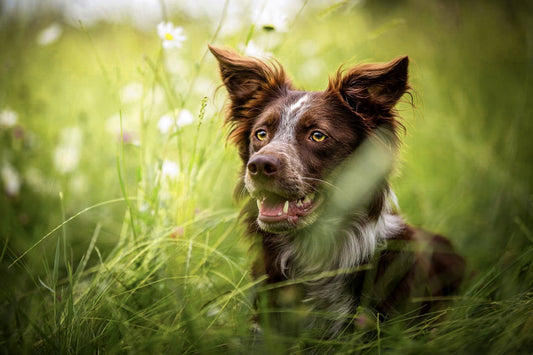Everybody knows a dog needs exercise. The question is how much and how often?
“How much exercise does this dog need?” is one of the most commonly asked questions by potential owners considering adoption. And yet, despite full commitment to the idea of what is needed, sometimes life takes over and the reality isn’t quite what it should be.
That’s why we thought it might be helpful to share some thoughts on how to best understand your dog’s exercise needs, and how to make it a bit more enjoyable for you in those moments when the sofa beckons. Our canine companions need their regular dose of activity to stay in tip-top shape. And, aside from the physical benefits (managing weight, maintaining flexibility and agility) exercise plays a pivotal role in their overall well-being, and mental health.
And yet, in the UK, 1 in 5 pet owners don’t take their four-legged friends for a daily stroll.
You might wonder how this is possible, but many people mistakenly believe that their back garden provides plenty of room for their dogs to roam freely. Now this may be the case if you’re the Duke of Richmond and your back garden is the Goodwood Estate, but for most dogs, it’s simply not big enough, stimulating enough or social enough for them to be at their best.
Dogs need more than just space to run in their outdoor time, they need genuine interactive engagement and stimulation. Research shows that when dogs don’t have the company of humans to encourage activity, they spend approximately 80% of their time snoozing. This snooze time slightly decreases to 60% when another dog is present, highlighting the importance of interaction and companionship in getting your dog active.
That said, as with all things, there is a flip side. Too much exercise can be as harmful as too little. And often it’s hard to know you’re over-exercising your dog given their joy at being out and about with you, desperate to keep up. I myself recently turned into a bit of a ‘Weekend Warrior’ pet owner. Swamped with work and kids during the week, exercise sessions were good but not the longest, so my partner and I decided to ramp up all of our exercise regime at the weekend.
Unfortunately, my poor Poppy, fell victim to over-exercise when my ‘ramping up’ resulted in us switching from a 5km walk to a 10km one Sunday. Seemingly happy and bouncy for most of it, it wasn’t until the last stretch that I noticed she was starting to struggle. Within a minute or two, she was up in my arms and I had to carry her the rest of the way home.
Poppy is a Doxiepoo in wolf’s clothing, but this time her limp was for real!
As Poppy jumped into her basket with a look of sheer joy at being home, I vowed it was time to learn how much and what type of exercise my and your canine companion needs to live their most active and best life.
Let’s Talk About The Advantages of Exercise

Engaging your dog in regular exercise is great because it supports so many fundamental elements of their health and overall happiness:
- maintains their ideal weight and keeps off any excess pounds from creeping on
- keeps their mind active and alleviates boredom (and unruly outbursts!)
- preserves the health of their musculoskeletal system
- regulates their nervous system to promote relaxation
- supports their digestive system
- builds confidence and encourages sociability, especially in timid or fearful pets
Without regular opportunities to run, play and engage in aerobic exercise, dogs can develop joint issues and conditions that affect their bones, joints, muscles and internal organs… along with doggy depression which is horrid for them, and can cause havoc at home.
Now, not all exercise is equal and finding the right balance of different activities is key. Keeping a daily routine that enables them to stay fit, alert and strong sets them up well for any weekend adventures that might be more strenuous. Games are amazing, what dog doesn’t love them, but even games need to be in moderation. Did you know that dogs are naturally front-heavy?
This puts a huge amount of strain on their front legs during activities like ‘fetch’. So it’s important to change things up within the routine, to make sure they’re not over-doing the same movements and working their joints in the same repetitive and strenuous way. This variety also does wonders for their mental health.
How To Determine Your Dog's Daily Exercise Requirements

The first step is to do some reading on your dog’s breed, and talk to other owners with pets of the same or similar breed and size. Every dog is different and has their own needs, but when you’re trying to figure out what ‘good’ looks like, nothing beats shared experience. That said, in general, most dogs require between 30 minutes to 2 hours of daily exercise, ideally split into 2-3 walks per day:
- The Minis - our smaller friends such as Yorkshire Terriers, Maltese, King Charles Spaniels, Miniature Dachshunds, Pomeranians, Chihuahuas, and Bichon Frises typically need around 30 minutes of exercise per day.
- The Mid Sizers - such as Bull Terriers, Cocker Spaniels, English Bulldogs, Miniature Poodles, Pugs, Miniature Schnauzers, and Shih Tzus will need around one hour of daily exercise.
- The Big Guys - our larger companions like Border Collies, Siberian Huskies, Labrador Retrievers, German Shepherds, Dalmatians, Boxers, and Golden Retrievers require at least two hours of daily exercise to thrive.
How To Keep Your Canine Companion Active

Keeping a dog nimble and lively takes a bit of work, for both human and dog. It means most walks need to be a little bit more pacey than just a leisurely stroll. Long-term vitality comes from more of a workout than a dawdle. At first I found this quite difficult (I am by nature a take-it-all-in-meanderer) but then I decided walking was to be my primary exercise activity, so I knuckled down and injected some power walking into my walks with Poppy. It’s great for the heart (both human and dog) and if you find your dog is a ‘sniff-piddle-dawdle’ walker, gradually integrating more cardio activity will really help with their overall health.
In addition to walking, you can also consider layering in other cardio activities such as fetch, swimming, frisbee, running, all combined with simple play at home. Trust me. They’ll love you for it! Adapting the type, duration, and intensity of exercise to suit your own pet’s needs and abilities is really important. Their happiness and well-being in Number 1. And remember that when making any changes, progress won't occur overnight; for your dog’s safety and enjoyment, a gradual approach is needed.
How To Spot The Signs of Over-Exercising

This article wouldn’t be complete if I didn’t touch on what can happen when dogs get over-exercised. Over-exertion is a thing, and the damage it can do can be long-term. Here are some signs to look out for, if you’ve been out and about with your dog more than usual:
- Sore Paw Pads: Keep an eye out for torn or damaged paw pads, as some dogs will push themselves to keep going even after they’ve injured their feet. This can lead to excruciating pain and difficulty walking.
- Sore Muscles: Just like humans, dogs can experience muscle soreness, especially after sudden bursts of activity following periods of inactivity. Watch for signs such as reluctance to move, struggling with stairs, or difficulty jumping.
- Sore Joints: Extreme exercise can strain a dog's joints, particularly the toes, knees, wrists, and elbows. Look for signs of reluctance to stand or walk, indicating potential joint pain.
- Heat Exhaustion: Overheating poses a severe risk, potentially leading to heat stroke. Certain breeds, like Boxers and French Bulldogs, as well as young and elderly dogs, are particularly vulnerable. Exercise during cooler parts of the day, provide ample water, and allow for frequent breaks to prevent heat-related issues.
- Behavioural and Physical Changes: Excessive exercise can trigger behavioural shifts, such as loss of interest in activities previously enjoyed. Watch for physical signs like excessive panting, difficulty breathing, dehydration, drooling, fever, changes in gum colour, decreased urine output, rapid pulse, tremors, lethargy, vomiting, diarrhoea, or dizziness.
We humans reap the same rewards as our four-legged friends from exercise making it the perfect shared activity. Paying attention to their cues, and adjusting their exercise accordingly, means exercise is a positive and rewarding experience for them and us.









